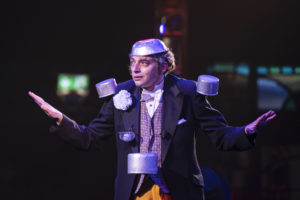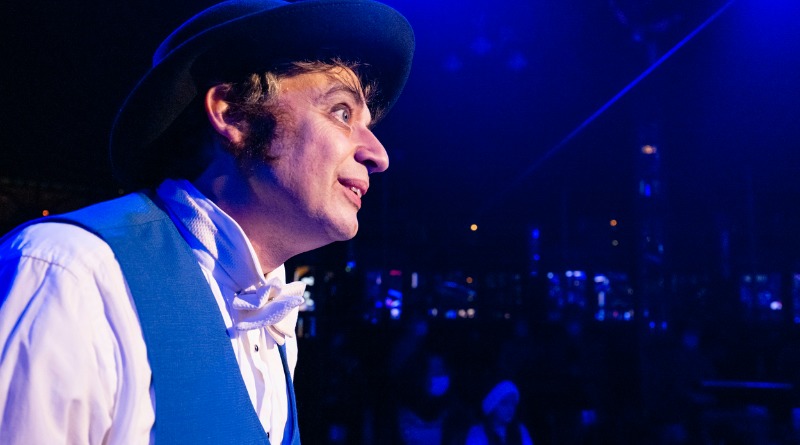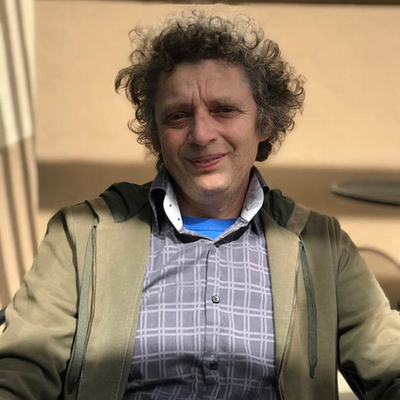Finding Your Clown Character
If in my first article, I drew our attention to having the right attitude for performing in front of an audience, then in the second, I would like to give more practical advice on how to find your clown character, image, role…
.‘As though’
Once I carefully asked a clown to explain to me, in words, his character: the role he plays. This clown distinguished himself by virtue of his wonderful timing, and could perform a number of circus tricks. Unfortunately, the personality of his character was poorly thought-out. This clown explained his character to me as follows: ‘Well, it’s as though I play a jolly person.’
He used the words ‘WELL’ and ‘AS THOUGH.’ This means that he does not know his clown, his character. We would hardly use the words ‘as though’ if we were acquainted with our clown’s personality on a detailed level.
It was true that this clown was always smiling during his performances. But his eyes did not show any emotion; they were empty, like those of a dried fish. He would draw his lips into a smile whether or not the scene was a happy one. Moreover, he would always be moving his lips, often squealing, or entertaining some dialogue that neither he nor the audience could understand.
Despite the fact that he could sprint on a wire, juggling six balls, and the audience would applaud him, it was only ‘as though’ he was successful.
In our performances, we should answer succinctly the question:
‘What is my personality? Who am I playing?’

.
Working on your character
The search for an idea
One of the ways to find your clowning character is to invent a biography for them. To do this, you need to ask yourself questions about them, such as, where does your character personality come from? Maybe the moon, or Mars? How old are they? What is it that they like, and don’t like? Who are their parents? How do they view women, and men…? What is their favourite food, their favourite drink? You need to know everything about your character, right down to the make of television that they have at home. Where they sleep, and at what time; what their hobbies are and why they love them. Ask yourself these questions, and try to answer them.
Interestingly, the answers to these questions can be found anywhere— in museums, on aircrafts, in shops, and in books. You need to make a habit of observing the world around you and letting the things you see inspire your work. For example, I find that working on your character is easier in art museums than anywhere else, because you can do this by looking at the paintings. Or if you already know the type of character you need to play– let’s say, a juggler, a musician, or a doctor— you can put into an image search engine the terms ‘jugglers/musicians/doctors,’ and look through as many of the images as you like. From these results, you can choose the version that seems most suitable for you.
I once for two days sat with the legendary designer Kym Barrett, who designed costumes for the characters in The Matrix films and Baz Luhrmann’s Romeo and Juliet, when we were both working on the show “Totem” for Cirque du Soleil. We were on the Internet looking through images of fish, trying to find the right one for our idea. For some reason, in these results, she saw an image of a cabbage white butterfly. It was thanks to this butterfly that Kym came up with the vision for my costume.
Similarly, if you still do not know which character you want to play, try going to an art gallery. You may find your idea there. Let’s say I know that red will be predominant in my costume for a show. Then this will be the aim of my visit: to look for everything I can find that is connected to the colour red. In doing this, I will definitely find a small detail that I can then use to inspire me in my show.
Scale and relativity
One of the most important keys to creating a convincing character is to define their dream. In order to do this, you need to understand the SCALE of a character’s personality and desires. For example, one person might be dreaming of buying a new sofa, another of becoming a cosmonaut; a third, the principal trainer of a hockey team; while a fourth dreams of travelling to Tibet and becoming a monk…
The RELATIVITY of a personality is your character’s weak or absurd side. For example, one person is a desperado who is always forgetting their umbrella. Or a superhero who saves the world from baddies, but has a shoelace that always comes undone on their right boot.
‘It’s a single step from the great to the humorous…’
…is what Napoleon said, after hitting his head on the ceiling of his carriage as he retreated from Moscow with his army. Let’s make use of this phrase.
The larger the scale of a character’s personality, the funnier their simplest problems can be. If a character dreams of the cosmos, maybe they will fly to the stars in their spaceship— but the spaceship, it seems, is full of everyday rubbish, which had been overlooked and not cleaned out before the launch. In this example, bits and pieces of rubbish float around our cosmonaut in his weightlessness, and maybe there is a superhero trying to fight against their ship.
Or it may be the other way around: your character is an everyday personality who dreams of just being left alone, who just wants to sit on his sofa eating popcorn and watch television shows. Suddenly, he is transported, along with his sofa, popcorn, and television, to the Tibetan mountains, where he ends up surrounded by meditating Buddhist monks.
Form, texture, and colour
It is extraordinarily important to define the form, texture, and even the colour palette of your character. Picture yourself as a child six years of age. What colours would you want to dress yourself in? What sort of personality do you have—is it rounded or square? Is your personality soft or hard? What does your personality sound like; is it a bass, falsetto, or soprano? What musical instrument can you equate to this personality: a flute, a trumpet, a clarinet, or a double bass? Your costume, shoes, and—where necessary— your makeup, will depend on the form, texture, and colour palette of your clown.
Alogism
If you are performing as a clown, then alogism should be present in the character you have created for yourself. It is a very important component, because clowns see and understand the world differently.
As the outstanding Russian clown of Armenian descent, Leonid Yengibarov, once said:
‘If you never forget one thing, it’s when you’re doing a handstand and you slowly lift one hand off the floor, and you understand that the globe is lying there in the palm of your hand.’ (1)
This is very poetic, and there is alogism in it too.
Another great clown of the 20th century, Grock, also said:
‘I love it when I am being beaten over the head with a hammer; when it stops, you experience such pleasure.’ (2)
Clowns break all laws legally. My clowning teacher used this example: say you are taking off your jacket— you throw it up in the air, and it sticks to the ceiling. For a clown, everything is the other way around, even the laws of gravity. If a clown started to wash a saucepan with their hands, they would dry it so hard that they would rub a hole in the dishcloth.
Alogism, however, does no harm to any type of performer, not just clowns. It makes your character come alive and makes them interesting, because the audience will not know how to read them. The audience, too, lives in accordance with the templates of social norms and logic. But when you disrupt that chain of events, then it remains in the audience’s minds, and the ideas that you share with them will be better accepted and better remembered.
At a large meeting with his students, my clowning teacher once removed his boot and put it on his head. He said, ‘There is every chance that out of everything we have discussed here, you will only remember this moment.’
Costumes, style, and clothing
Once I was entertaining the participants of an international conference of Nobel Prize Laureates as a clown. This conference, held in the Swiss city of Zermatt, was dedicated to recent innovations made in culture, science, and literature, and it had a formal dress code.
Among the performers present was Jon Lord, the British composer and keyboardist. He had been invited to perform because of his brilliant composition ‘Smoke On The Water,’ which had inspired new directions in modern music. As was the required dress, Jon arrived on stage in a dinner jacket, but with black flip flops on his bare feet. It was this detail that lent him charisma and made his performance more memorable.
There were an enormous number of famous people at the event, but I remember Jon Lord and that detail of his wardrobe more clearly, and with more affection, as it did not fit in with the same templates the others followed. Of course, he is a musician, and it is normal for musicians to dress a bit eccentrically. Overall, however, he matched the required style, only changing that one small detail.
Despite the fact that all styles and fashions are themselves clichés, we should still follow those clichés, while also bringing something of ourselves to them.
Now, so that we feel more confident, and so those around us will take us seriously, let’s work on our wardrobes a little bit.
These are the six most widely adopted fashion styles:
- The classic style;
- The sporty style;
- The romantic style;
- The cultural style;
- The retro style;
- The casual style.
Also to consider are the four emotional states: 1) fading out; 2) rebirth; 3) creativity; 4) withering away, which are linked to the four seasons— winter, spring, summer, and autumn.

A clown’s costume or clothing style should reflect the personality, emotions, and setting of their character. We might choose the most appropriate style for each event that we go to, for each meeting. Even so, we add a small but, at first glance, indiscernible detail from our own selves to our outfit— a little emotional note, which corresponds to one or another of the emotional states, or to the time of year. It should be the same way for our clown.
Exercise
I would like to offer you an exercise that will bring you closer to finding your clown character. The first step is to pick a season.
Next in preparation, have on hand your video camera or smartphone, some simple text— a song, a lyric poem, or whatever else you like— and a recording of Antonio Vivaldi’s concertos The Four Seasons.
Your outfit, where possible, should be in one of the six listed styles. Try to dress in a way that corresponds to each style in turn. I would advise you to start with the classical style and add to your outfit a small, almost indiscernible accessory in line with your chosen season. This could be a brooch, a badge, a scarf, and so on. Just find your accessory, and don’t trust the first idea that comes into your head.
In order to create the proper atmosphere, switch on the recording of The Four Seasons and turn to the concerto of your choice, for example, ‘Winter.’ Almost ready? If you are, then switch on your camera or smartphone and stand approximately three steps away from the camera, so that you fill the entire frame.
If you are ready, then start to dance to Vivaldi’s music. Your movements should be your own; just get a feel for the music. With the music’s help, begin to enter the atmosphere of your chosen season. Move for one and a half minutes and then stop.
Then, let the music keep playing, and start to read your text aloud in the spirit of that specific time of year. That is to say, if it is winter, then imagine yourself standing in the snow, or with a blizzard around you. If it is spring, then imagine the birds singing and fresh flowers. If your season is autumn, then imagine the rain; and if it is summer, then the scalding sun, the heat. Recite your text as if you were in that environment and try to gesticulate. Only add hand movements to make it more convincing. Don’t, however, be overzealous: I often find myself thinking that people, when recording vlogs, gesticulate deliberately in front of the camera—but they don’t do it theatrically enough, so their hands and their words seem to move separately from one another. It should all look natural.
Do this exercise for each of the four seasons, and in each of the six fashion styles. When you are done, watch all of the video recordings back. Analyse which of the styles you felt most comfortable in. That style can be the basis for your character.
At the moment when you watch the recordings, be your own director, and not an artiste. You can improve on what you like about your performance, and take out what you don’t like, later on. Don’t forget to accept yourself—and your character— for who they are. For this to happen, do not take yourself and your dance, costume, or mannerisms too seriously.
Main image: The Author, Misha Usov Photo: Tobias Sutter
 Mikhail (Misha) Usov is the author of “The Invisible Clown: How to Not Be Afraid of Being Yourself.” In his first book published outside Russia, Misha reveals the acting, communications, and public speaking discoveries that led to his 36-year success as an international performer on five continents and creative artist for Cirque du Soleil. The Invisible Clown is essential reading for any performing artist, ready to shed the patterns that cause creative blocks, stage fright, inconsistent performances, waning artistic energy, and the fear of being yourself.
Mikhail (Misha) Usov is the author of “The Invisible Clown: How to Not Be Afraid of Being Yourself.” In his first book published outside Russia, Misha reveals the acting, communications, and public speaking discoveries that led to his 36-year success as an international performer on five continents and creative artist for Cirque du Soleil. The Invisible Clown is essential reading for any performing artist, ready to shed the patterns that cause creative blocks, stage fright, inconsistent performances, waning artistic energy, and the fear of being yourself.
.
...Do you have a story to share? Submit your news story, article or press release.




